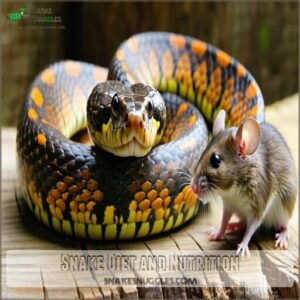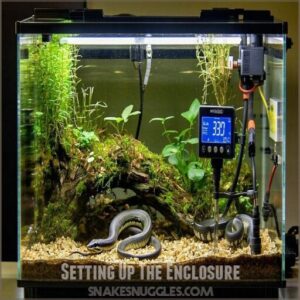This site is supported by our readers. We may earn a commission, at no cost to you, if you purchase through links.

Corn snakes are a favorite—they’re gentle, hardy, and come in stunning colors.
Ball pythons are another great option; they’re known for their docile nature and manageable size.
Kenyan sand boas stay small and prefer burrowing, making them fascinating to watch.
Hognose snakes are adored for their quirky upturned noses and mild temperaments.
These breeds typically have simple feeding needs, long lifespans, and minimal care requirements.
With the right setup, you’ll create a perfect home for your new pet.
Table Of Contents
- Key Takeaways
- Choosing The Right Snake
- Beginner-Friendly Snake Breeds
- Snake Care Essentials
- Understanding Snake Behavior
- Snake Diet and Nutrition
- Health and Hygiene
- Creating a Snake-Friendly Environment
- Handling and Interacting With Snakes
- Common Beginner Mistakes
- Long-Term Commitment and Responsibility
- Frequently Asked Questions (FAQs)
- What are the best beginner pet snakes?
- Are there snakes for beginners?
- How do I choose a pet snake?
- Are snakes good pets?
- Are corn snakes good pets for beginners?
- What is the best snake for a beginner?
- What is the least aggressive snake to own?
- What is the best snake to tame?
- Can snakes bond with owners?
- What is the best beginner snake to own?
- Conclusion
Key Takeaways
- Pick beginner-friendly snakes like corn snakes, ball pythons, or Kenyan sand boas—they’re calm, easy to handle, and need simple care.
- Set up a proper enclosure with the right size, heating, hiding spots, and substrate to match your snake’s natural habitat.
- Learn to handle your snake gently and consistently to build trust while avoiding overhandling and stressing them out.
- Plan for the long-term with careful budgeting for food, equipment, and veterinary costs, as snakes can live 15–30 years.
Choosing The Right Snake
Choosing the right snake means matching its needs with your lifestyle and experience. You’ll want to evaluate factors like size, temperament, and care requirements to guarantee a good fit.
Match your snake’s size, temperament, and care needs to your lifestyle for a rewarding and stress-free reptile experience.
Researching Snake Species
Researching snake species is vital for finding beginner snakes that suit your lifestyle.
Focus on their natural habitat, lifespan, and care needs to guarantee compatibility.
- Species Identification: Learn their quirks and traits.
- Morph Variations: Explore unique colors and patterns.
- Habitat Research: Match enclosures to their origins.
- Temperament Traits: Choose docile beginner snake breeds.
- Dietary Needs: Be prepared for rodents or insects.
Understanding these factors guarantees the best pet snakes for you.
Considering Temperament and Handling
When choosing beginner snakes, temperament matters.
Docile species like corn snakes and ball pythons are easy to handle snakes, making them great for building confidence.
A snake’s personality varies—some are naturally calm, while others might seem shy or defensive.
Watch for signs like hissing or striking, which can indicate stress.
Always handle gently and keep sessions short at first.
Regular handling helps snakes adjust, but don’t overdo it.
If child safety is a concern, stick to docile snakes with a low bite risk for worry-free interactions.
Evaluating Cost and Lifespan
Understanding the cost and lifespan of beginner-friendly snakes is key to planning. Snakes often live 10-30 years, depending on the breed, so think long-term.
Here’s a breakdown:
- Initial investment: Affordable snakes like corn snakes or rosy boas cost $50-$200, plus $50-$300 for enclosures.
- Long-term expenses: Monthly feeding averages $5-$30.
- Veterinary costs: Routine checkups guarantee health but can add up.
- Breed longevity: Corn snakes and ball pythons boast impressive lifespans, offering years of companionship.
Plan wisely for sustainable snake care.
Assessing Your Experience Level
Reflecting on your prior reptile experience helps you find the best starter snake. Ask yourself: Do you have the handling confidence and husbandry skills needed for beginner-friendly snakes?
Beginner snakes like corn snakes or ball pythons are great if you’re still building those skills. Research commitment and long-term dedication are also key to snake care.
Use the table below to match your expertise with a beginner snake species:
| Skill Level | Space Needed | Recommended Snake |
|---|---|---|
| Beginner | Small enclosure | Corn Snake |
| Moderate | Medium enclosure | Ball Python |
| Experienced | Larger enclosure | Kenyan Sand Boa |
This approach will help you choose a snake that fits your husbandry skills and experience level, ensuring a positive and rewarding experience for both you and your pet.
Beginner-Friendly Snake Breeds
When you’re starting out with pet snakes, it’s important to choose species that are easy to care for and handle.
Beginner-friendly breeds like corn snakes and ball pythons are known for their manageable size, calm temperament, and simple care needs, making them a great choice for those new to snake ownership, with ball pythons being particularly popular.
Corn Snakes and Ball Pythons
If you’re seeking beginner-friendly snakes, corn snakes and ball pythons are top picks.
Corn snakes, known for their vibrant morph variations and adaptability, thrive with minimal effort.
Ball pythons stand out for their calm temperament differences and wide enclosure enrichment options.
Both are docile snakes, easy to care for, and offer excellent breeding potential, making them perfect beginner snakes for any aspiring reptile enthusiast.
Hognose and Kenyan Sand Boas
Hognose snakes and Kenyan sand boas are beginner snake species that are low-maintenance and enchanting.
The Western Hognose Snake features unique morphs and performs creative defensive behaviors, like hooding its neck. Kenyan Sand Boas thrive in burrowing environments and have calm temperaments.
Here’s why they’re great for beginners:
- Temperament: Both species are docile and easy-going.
- Diet: Simple feeding habits focusing on small prey.
- Enclosure Setup: Compact tanks mimic natural habitats.
- Handling: Easy and stress-free interactions.
Garter and Dekay’s Brown Snakes
Garter and Dekay’s Brown Snakes are beginner-friendly snakes with minimal care needs and docile temperaments.
They are easy to handle and care for, making them a great choice for snake enthusiasts.
Garter variations thrive in diverse climates, enjoying worms, insects, and more.
These lively snakes adapt well to habitat enrichment with water sources or climbing structures.
Meanwhile, Dekay’s Brown Snakes are EasytoCare Snakes, thriving in woodlands and feeding on slugs or worms.
Though shy, they’re calm once adjusted, and handling frequency should remain moderate to avoid undue stress.
| Snake | Ideal Habitat | Preferred Diet |
|---|---|---|
| Garter | Varied climates | Worms, insects |
| Dekay’s Brown | Woodland areas | Slugs, worms |
Snake Care Essentials
Taking care of a pet snake means understanding its basic needs, like enclosure size, temperature, and humidity. Providing the right setup guarantees your snake stays healthy and stress-free.
Enclosure Size and Temperature
When setting up a snake enclosure, size and temperature are vital for their well-being. Aim for dimensions at least 2/3 the snake’s length. Provide essential temperature gradients to mimic their natural habitat.
Use a heating element or substrate heating paired with a thermostat to control warmth precisely. Follow these steps for proper setup:
- Create a warm basking spot (85-95°F) using heat sources.
- Maintain a cool zone around 70-75°F for temperature balance.
- Use a thermostat for accurate monitoring and safety.
- Regularly check temperatures with reliable tools to confirm consistency.
Proper snake heating fosters health and comfort. To prevent overheating, consider thermal management strategies for the enclosure.
Lighting and Humidity Requirements
Consistent humidity levels and proper lighting types keep your snake healthy and comfortable. Aim for snake humidity matching their natural environment to prevent shedding issues.
Use a basking spot and temperature control for the right snake lighting and snake temperature levels year-round. Enclosure misting can boost humidity when needed.
- Provide a 12-hour light/dark cycle for natural rhythms.
- Ventilate well to avoid stale air.
- Monitor humidity and temperature closely using reliable tools.
Choosing The Right Substrate
When setting up snake enclosures for beginner-friendly snakes, choosing snake substrates depends on their burrowing needs, humidity control, and how often they need cleaning.
For low-maintenance options, consider aspen shavings (natural look, weekly cleaning), coconut fiber (tropical feel, bi-weekly cleaning), or newspaper (minimalist, daily cleaning).
Reptile carpet suits practical setups, while cypress mulch offers rustic charm but monthly cleaning.
Proper substrate depth is also essential for burrowing species.
Avoid loose substrates for species prone to impaction risk, ensuring a safe, comfortable, and functional habitat setup.
Understanding Snake Behavior
You’ll need to learn your snake’s body language to provide proper care and prevent stress.
Understanding the normal behaviors of beginner-friendly snakes like corn snakes and ball pythons helps you build trust with your pet and identify potential health issues early, which is crucial for proper care and can help prevent stress.
Recognizing Stress and Aggression
After setting up your snake’s habitat, you’ll need to understand their body language. Recognizing stress and aggression in docile snakes helps prevent handling issues.
Watch for these warning signs:
- Hissing and striking when approached
- Defensive postures like coiled body with raised head
- Erratic movements or attempting to flee quickly
- Appetite changes or refusing food
Excessive hiding behavior often indicates stress.
Make certain proper temperature and minimal disturbances to maintain your snake’s comfort.
Identifying Healthy Behavior
Now that you know what stress looks like, let’s talk about healthy snake behavior.
A happy snake shows active exploration of its environment. You’ll notice alert posture with smooth, purposeful movement. BeginnerFriendly snakes typically maintain consistent appetite and eat without hesitation.
Regular shedding occurs in one complete piece. Docile snakes will have clear eyes (except during pre-shed) and respond calmly to movement near their enclosure.
Active, alert movement
Good appetite, eats readily
Handling and Taming Techniques
Successful snake handling requires patience and technique.
Start with docile snakes like corn snakes or ball pythons. Always use safe restraint methods, supporting the snake’s body properly.
Practice hook training for defensive species and implement desensitization methods gradually. Learn to read cues—flicking tongue means curiosity, while hissing indicates stress.
Short, frequent sessions build trust and prevent bites. Your snake’s temperament will improve with consistent, gentle interaction.
It’s vital to understand safe handling techniques to minimize stress.
Snake Diet and Nutrition
You’ll need to understand what your pet snake eats and how often to feed it for ideal health and growth.
Beginner-friendly snakes like corn snakes and ball pythons typically eat pre-killed mice or rats that match their body width, with feeding schedules varying from weekly for juveniles to every 2-3 weeks for adults.
Feeding Insects and Rodents
Through proper feeding practices, you’ll keep your beginner-friendly snake healthy and thriving.
Choose prey size matching your snake’s girth – a meal shouldn’t exceed the widest part of your snake’s body.
Frozen rodents are safer than live ones, eliminating injury risks.
Most small species need feeding every 5-7 days.
If your snake refuses to eat, try warming the prey slightly or feeding at night when many are naturally active.
Providing a Balanced Diet
You’ve mastered feeding your snake rodents, now let’s focus on their overall nutrition.
A balanced snake diet consists of more than just food items:
- Prey size matching: Select appropriately sized food (10-15% of your snake’s body weight) to prevent digestion issues.
- Feeding frequency: Young snakes eat weekly, adults every 1-2 weeks.
- Nutritional variety: Offer different prey types for complete nutrition.
Always provide fresh water alongside meals for proper hydration.
Avoiding Overfeeding and Underfeeding
After establishing your snake’s dietary needs, maintaining proper portion control is equally important. Overfeeding or underfeeding can lead to serious health issues.
Monitor your snake’s weight regularly – a healthy snake should feel firm but not bloated. Adjust prey size based on your snake’s body width – generally, prey should be 1-1.5 times the widest part of your snake’s body.
| Feeding Issue | Signs | Solution |
|---|---|---|
| Overfeeding | Obesity, regurgitation | Reduce feeding frequency |
| Proper feeding | Smooth shedding, active behavior | Maintain schedule |
| Underfeeding | Visible spine, lethargy | Increase prey size |
Health and Hygiene
You’ll need to monitor your snake’s health and keep its habitat clean to prevent common issues like respiratory infections and scale rot.
Regular cleaning of the enclosure and careful observation of your snake’s behavior will help you catch potential problems early, ensuring your scaly friend stays healthy for years to come, with a clean environment that prevents issues like respiratory infections.
Recognizing Common Health Issues
After ensuring your snake has the right diet, you’ll need to monitor for health issues. Beginner-friendly snakes can still develop problems that require attention.
- Respiratory infections: Watch for wheezing, coughing, or nasal discharge
- Scale rot: Check for red or discolored scales in damp areas
- Mites & ticks: Look for tiny black/red dots, especially around eyes and mouth
- Regurgitation: Could indicate stress or improper temperature
- Obesity: Caused by overfeeding, leading to shortened lifespan
Regular health checks help catch these issues early.
Maintaining a Clean Environment
Now that you can spot health problems, let’s keep them away with proper cleaning.
Your snake’s home needs regular waste removal and spot cleaning daily.
Change water dishes daily to prevent bacteria growth.
Deep clean the entire enclosure monthly with reptile-safe disinfectants.
Choose substrates that manage moisture and are easy to clean.
Proper shedding management includes removing old skin promptly.
A clean enclosure means a healthier, happier snake with proper cleaning.
Quarantining and Isolating Snakes
When you bring home a new snake, set up a quarantine space for at least 30 days. This simple step helps catch health issues before they spread to other pets.
Your isolation setup should include:
- A separate enclosure with proper heating
- Daily health checks for unusual behavior
- Basic supplies that won’t transfer between snakes
- A calm environment to reduce stress
Monitor carefully and wash hands between handling.
Creating a Snake-Friendly Environment
You’ll need to create proper housing that meets your snake’s specific temperature, humidity, and habitat needs to guarantee its health and comfort.
Your enclosure should include appropriate substrate, secure hiding spots, climbing branches for arboreal species, and the correct heating equipment to maintain temperature gradients.
You should ensure the enclosure is well-equipped with the necessary features to support the snake’s overall well-being, including secure hiding spots.
Setting Up The Enclosure
Your snake’s enclosure is its entire world. Choose a tank that’s at least two-thirds your snake’s total length—a corn snake needs different space than a ball python.
Select appropriate substrate based on your snake’s natural habitat: aspen for corn snakes, cypress mulch for ball pythons.
Maintain proper temperature gradients (75-85°F cool side, 85-95°F warm side) using under-tank heaters or ceramic heat emitters. Monitor humidity levels with a digital hygrometer, adjusting based on species requirements.
For beginner snake setup, glass terrariums with secure, ventilated lids work best, preventing escapes while ensuring proper airflow. You can find all the necessary enclosure supplies to get started.
Providing Hiding Places and Climbing Structures
Now that your enclosure is ready, it’s time to add those essential comfort features. Every snake needs proper hiding spots—secure, tight-fitting caves or artificial hideouts where they can retreat when stressed.
For enclosure enrichment, include climbing structures like branches or vines, especially for arboreal species. Natural-looking dwellings such as hollow logs or stone structures create a more naturalistic design while providing security.
Many keepers find suitable reptile caves online for their snakes. Remember, all decor must be firmly secured to maintain structural integrity.
Maintaining Temperature Gradients
Your reptilian friend needs proper temperature gradients just like they’d find in nature.
After creating those perfect hiding spots, focus on maintaining heat zones:
- Setup basics: Position heat sources on one side of the enclosure, creating warm and cool ends (85-90°F vs. 75-80°F).
- Thermostat control: Always use thermostats to prevent overheating and maintain stable gradient zones.
- Monitoring methods: Use digital thermometers at both ends to confirm species needs are met.
Different snake species have specific temperature requirements, so research your particular pet’s needs.
Handling and Interacting With Snakes
You’ll build trust with your beginner snake through gentle, consistent handling that respects their natural behaviors and comfort levels.
Regular interaction using proper support techniques helps your snake become comfortable with human contact while reducing stress responses that might trigger defensive reactions, which is crucial for establishing a strong bond and can be achieved by respecting their natural behaviors.
Gentle Handling Techniques
When approaching your snake, use safe lifting techniques that provide full body support.
Start with gradual introduction sessions, keeping movements slow and deliberate to avoid startling your pet. Watch for stress signals like rapid tongue flicking or tense muscles.
Always support properly by holding the middle third of their body, never grabbing the tail or head. Employing secure enclosure requirements is also critical for preventing escapes.
These snake handling techniques guarantee comfort and safety for both you and your reptilian companion, ensuring a positive experience with proper handling and secure enclosures.
Building Trust and Confidence
Now that you understand handling basics, building trust with your snake requires consistent practice and observation.
Your steady approach will develop a comfortable relationship over time:
- Feel rewarded when your snake relaxes in your hands, showing trust
- Experience satisfaction watching your docile snake species grow accustomed to your presence
- Gain confidence as you learn to read their subtle body language cues
Gradual introduction and patience are essential. Start with brief, positive interactions, slowly increasing duration as your snake shows comfort signals.
Avoiding Stress and Aggression
To avoid stress and aggression in your snake, practice safe handling techniques like supporting their entire body and moving slowly.
Recognize signs of stress such as defensive postures, hiding excessively, or refusing food. Provide proper enclosure enrichment with multiple hiding spots and appropriate substrate.
For docile snake species like corn snakes and ball pythons, gradual acclimation to handling helps reduce fear. Remember that snake temperament varies—even typically nonaggressive snakes may become stressed during shedding or after feeding.
A calm environment leads to a peaceful relationship.
Common Beginner Mistakes
You’ll make common mistakes with your first snake if you don’t research their specific needs for space, temperature, and handling.
The most frequent errors include choosing the wrong species for beginners, providing inadequate enclosure size, and improper feeding schedules that can impact your pet’s health, which are critical mistakes that can be avoided with proper research and understanding of complete concepts.
Inadequate Research and Planning
Many new snake owners jump into pet ownership without proper research, leading to serious welfare issues.
Adequate preparation means understanding species needs, temperament, and the true cost of snake pet ownership.
Enclosure size problems often cause health issues in captive snakes.
Before bringing your snake home, find a reptile-experienced veterinarian and learn to replicate its natural environment.
Lifespan unpreparedness can lead to abandoned pets when owners realize snakes may live 20+ years.
Don’t overestimate your experience level—some beginners mistakenly choose advanced species requiring specialized care.
Some owners fail to consider the long-term commitment required for snake ownership, which can be a significant issue for those who are not prepared for the responsibilities that come with caring for a pet that may live for many years.
Insufficient Space and Equipment
The top three mistake beginner snake owners make is underestimating space and equipment needs.
Your snake’s habitat directly impacts its health and happiness.
Consider these essential requirements:
- Proper enclosure size: A ball python needs at least a 40-gallon tank, while corn snakes require 20+ gallons based on their adult size.
- Adequate heating equipment: Invest in quality thermostats, not just heat mats.
- Appropriate hides: Every snake enclosure needs a minimum of two hides for security.
DIY habitats work well when space constraints exist, but never compromise on essentials.
Poor Handling and Care Techniques
From equipment to handling, each mistake impacts your snake’s well-being.
Improper handling techniques create stressful environments for beginner snakes.
You’ll want to avoid overhandling snakes, especially when they’re settling in.
Maintain correct temperatures and clean enclosures regularly.
Watch for signs of snake stress like hiding excessively or refusing food.
Improper feeding methods can lead to digestive issues.
When you understand snake temperament, you’ll build trust and guarantee your reptile thrives.
Long-Term Commitment and Responsibility
You’ll need to keep in mind that snakes can live for 15-30 years, requiring consistent care throughout their entire lifespan.
The initial setup costs for proper housing, heating equipment, and regular feeding expenses will continue for decades, so choose a beginner-friendly species like a corn snake or ball python that matches your long-term commitment level to ensure a long-term care plan.
Understanding Snake Lifespan
When choosing a snake companion, understanding their lifespan is vital—it’s a decades-long commitment.
Snake lifespan varies widely by species and care quality:
- Corn snakes typically live 15-20 years with proper care
- Ball pythons often reach 20-30 years in captivity
- Smaller species like garter snakes generally live 10-15 years
Most beginner snakes live 15+ years with proper nutrition, habitat, and veterinary care—longer than many traditional pets.
Providing a Forever Home
Now that you understand your snake’s potential decades-long lifespan, it’s time to create their forever home.
Ethical sourcing matters—consider adopting rescue snakes instead of wild-caught specimens. The best pet snakes for beginners often come from reputable breeders or rescue organizations.
Your snake care tips should include long-term planning for housing upgrades as your reptile grows. Responsible ownership means committing to a snake’s entire life, not just when it’s convenient.
A proper setup isn’t just a cage—it’s a sanctuary where your beginner reptile pet will thrive for many years, and it requires long-term planning and a commitment to responsible ownership.
Considering The Costs and Time
Beyond choosing the right home for your snake, you’ll need to ponder the financial reality of snake ownership.
Initial setup costs for beginner-friendly breeds range from $200-500, covering enclosure, heating, and accessories.
Ongoing expenses include food ($10-25 monthly), substrate replacements, and occasional veterinary care ($75-150 per visit).
Budget planning is vital, as most snake breeds live 15-25 years.
The time commitment involves weekly cage cleaning and regular monitoring.
To guarantee a healthy environment, it’s important to understand reptile habitat maintenance, which is crucial for long-term care.
Frequently Asked Questions (FAQs)
What are the best beginner pet snakes?
What’s a great pet for beginners curious about snakes?
Corn snakes, ball pythons, and rosy boas top the list.
They’re docile, low-maintenance, and easy to handle, making them perfect starter snakes for anyone new to reptiles.
Are there snakes for beginners?
Yes, there are snakes perfect for beginners.
Corn snakes, ball pythons, and rosy boas are ideal choices.
They’re docile, easy to care for, and adapt well to captivity, making them great starter reptiles.
How do I choose a pet snake?
Think of choosing a pet snake like picking a perfect puzzle piece.
Match its size, temperament, and care needs to your lifestyle.
Research species, verify proper housing, and consider handling ease before deciding.
Are snakes good pets?
Snakes can make fascinating pets if cared for properly.
They’re quiet, require minimal daily maintenance, and adapt well to captivity.
Research specific species’ needs, verify proper setup, and handle them gently for a rewarding experience, which includes understanding their complete concepts.
Are corn snakes good pets for beginners?
Corn snakes are excellent for beginners.
They’re docile, easy to handle, and adapt well to captivity.
With simple care needs, vibrant colors, and a manageable size, they make snake ownership approachable and enjoyable for newcomers.
What is the best snake for a beginner?
In the case of the perfect beginner snake, a corn snake checks all the boxes.
It’s easy to care for, adaptable, and gentle, with stunning colors that make handling feel less like a task, and is a perfect example of a beginner-friendly pet.
What is the least aggressive snake to own?
If you want a calm, easygoing snake, a Ball Python is a top choice.
They rarely bite, have a docile temperament, and are easy to handle, making them perfect for a peaceful pet experience.
What is the best snake to tame?
The best snake to tame is the Ball Python.
It’s naturally calm, adapts well to handling, and rarely strikes.
With patience and gentle care, it becomes a docile, trustworthy companion, perfect for beginners.
Can snakes bond with owners?
Snakes don’t bond like dogs or cats, but over time, they can recognize you through scent and handling.
Your consistent care builds trust, making them calmer and more comfortable during interactions.
What is the best beginner snake to own?
A corn snake is an excellent choice for beginners.
It’s docile, easy to handle, and thrives in captivity.
With stunning colors, simple care needs, and adaptability, this snake fits perfectly for new reptile enthusiasts.
Conclusion
Venturing on the journey of snake ownership can feel like opening a door to a fascinating new world.
By choosing the best snake breeds for beginners—like corn snakes, ball pythons, or Kenyan sand boas—you’re investing in a calm, easy-to-care-for companion.
Focus on proper handling, a suitable habitat, and a balanced diet to guarantee your pet thrives.
With patience and commitment, keeping snakes can be a rewarding experience, offering years of discovery and connection with these unique creatures.
- https://portal.ct.gov/-/media/DEEP/wildlife/pdf_files/outreach/fact_sheets/brownsnakepdf.pdf
- https://www.snakesociety.nl/jaargangen/1986e/Litteratura%20Serpentium%206-3%20098-106%20vdPols,%20Husbandry%20and%20breeding%20of%20Lichanura%20trivirgata%20roseofusca.pdf
- https://lazoo.org/explore-your-zoo/our-animals/reptiles/rosy-boa/
- https://terrariumquest.com/pet-snakes-for-beginners/
- https://reptilesmagazine.com/5-great-beginner-pet-snakes/




















